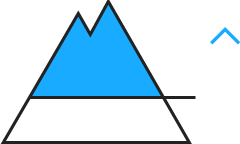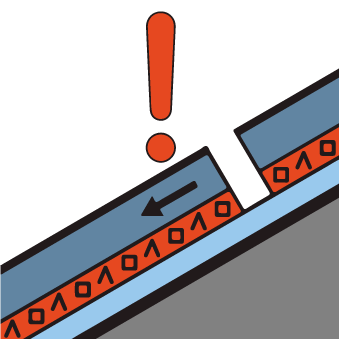
Danger level
 | 1600m
|
Avalanche Problem
 | | Wind-drifted snow |
|  | |  |
 | | Persistent weak layer |
|  | |  |

A critical avalanche situation will be encountered over a wide area.
The danger exists in particular in alpine snow sports terrain. Great caution and restraint are important.
As a consequence of new snow and a strong to storm force northwesterly wind, further wind slabs will form. Avalanches can in many places be released very easily and reach large size. More natural avalanches are possible. Remotely triggered avalanches are to be expected, this also applies in areas close to the tree line, as well as below the tree line. The avalanche prone locations are difficult to recognise.
In addition a latent danger of gliding avalanches exists, in particular in the regions with a lot of snow.
Snowpack
dp.6: cold, loose snow and wind
dp.5: snowfall after a long period of cold
10 to 30 cm of snow will fall. The sometimes storm force wind will transport the fresh and old snow. The old snowpack is faceted and its surface consists of surface hoar. The brittle wind slabs are lying on the unfavourable surface of an old snowpack. As a consequence of low temperatures the snowpack can not consolidate. Whumpfing sounds and the formation of shooting cracks when stepping on the snowpack and stability tests confirm the unfavourable bonding of the snowpack.
Tendency
A critical avalanche situation will be encountered over a wide area.

Danger level
 | treeline
|
Avalanche Problem
 | | Wind-drifted snow |
|  | |  |
 | | Persistent weak layer |
|  | |  |

A dangerous avalanche situation will be encountered in some regions. Fresh and older wind slabs represent the main danger.
Fresh snow and large quantities of wind-drifted snow are very prone to triggering in all aspects, also in areas close to the tree line, as well as below the tree line. Avalanches can in many places be released very easily and reach large size in isolated cases.
Natural avalanches are possible. As a consequence of the sometimes storm force wind the wind slabs will increase in size additionally as the day progresses. In addition a latent danger of gliding avalanches exists.
Caution and restraint are important.
Snowpack
dp.5: snowfall after a long period of cold
dp.8: surface hoar blanketed with snow
Some snow will fall in some localities. The old snowpack consists of faceted crystals; its surface is loosely bonded and consists of surface hoar and faceted crystals. The sometimes storm force wind has transported the loosely bonded old snow. The brittle wind slabs are lying on unfavourable layers in all aspects.
Precarious weak layers exist in the centre of the snowpack.
Tendency
The avalanche conditions are to some extent precarious. Fresh and older wind slabs are to be assessed with care and prudence.

Danger level
 | 1800m
|
Avalanche Problem
 | | Wind-drifted snow |
|  | |  |
 | | Persistent weak layer |
|  | |  |

A critical avalanche situation will be encountered over a wide area.
The new snow and wind slabs can be released easily or naturally in all aspects. This applies in particular on wind-loaded slopes. Avalanches can penetrate deep layers and reach large size. Caution is to be exercised also below the tree line. The avalanche prone locations are sometimes covered with new snow and are difficult to recognise. Remotely triggered avalanches are possible. Slides can occur on cut slopes. In the north the avalanche prone locations are more prevalent and the danger is greater. Gliding avalanches can also occur.
Great caution and restraint are important.
Snowpack
dp.5: snowfall after a long period of cold
dp.6: cold, loose snow and wind
10 to 20 cm of snow will fall on Sunday. The old snowpack is faceted; its surface is loosely bonded and consists of surface hoar and faceted crystals. The sometimes storm force wind will transport the new snow and, in some cases, old snow as well. The brittle wind slabs are lying on the unfavourable surface of an old snowpack. Whumpfing sounds and the formation of shooting cracks when stepping on the snowpack and avalanches triggered by explosives confirm poor snowpack stability.
Tendency
A critical avalanche situation will prevail. Caution and restraint are important.

Danger level
 | treeline
|
Avalanche Problem
 | | Wind-drifted snow |
|  | |  |
 | | Persistent weak layer |
|  | |  |

A sometimes critical avalanche situation will prevail.
The fresh and somewhat older wind slabs can be released easily. or in isolated cases naturally, in all aspects. This applies above the tree line, as well as in areas close to the tree line. Mostly avalanches are medium-sized. As a consequence of the strong wind the wind slabs will increase in size additionally as the day progresses. Remotely triggered avalanches are possible in isolated cases.
Caution and restraint are important.
Snowpack
dp.6: cold, loose snow and wind
dp.8: surface hoar blanketed with snow
5 to 10 cm of snow, and even more in some localities, has fallen since Wednesday. The strong wind has transported the fresh and old snow significantly. The old snowpack consists of faceted crystals; its surface is loosely bonded and consists of surface hoar and faceted crystals. The brittle wind slabs are lying on unfavourable layers.
Isolated avalanche prone weak layers exist in the top section of the snowpack. Whumpfing sounds and the formation of shooting cracks when stepping on the snowpack have confirmed poor snowpack stability.
Tendency
A critical avalanche situation will be encountered in some regions. Caution and restraint are recommended.













